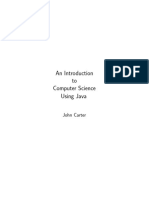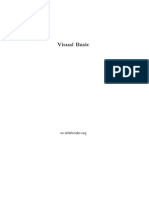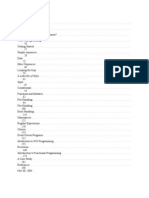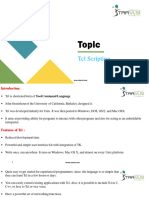0 ratings0% found this document useful (0 votes)
120 viewsIntroduction To Python
This document provides an overview and curriculum for an Introduction to Python course. The course covers Python basics like data types, variables, strings, conditionals, loops and functions. It then covers sequence data types like lists and strings in more depth, including indexing, slicing and common methods. Later units cover modules, file handling, more advanced statements and structures like dictionaries and tuples. The course aims to prepare students to take the MTA 98-381 certification exam on Introduction to Programming Using Python.
Uploaded by
Cuitlahuac AlamillaCopyright
© © All Rights Reserved
We take content rights seriously. If you suspect this is your content, claim it here.
Available Formats
Download as PDF, TXT or read online on Scribd
0 ratings0% found this document useful (0 votes)
120 viewsIntroduction To Python
This document provides an overview and curriculum for an Introduction to Python course. The course covers Python basics like data types, variables, strings, conditionals, loops and functions. It then covers sequence data types like lists and strings in more depth, including indexing, slicing and common methods. Later units cover modules, file handling, more advanced statements and structures like dictionaries and tuples. The course aims to prepare students to take the MTA 98-381 certification exam on Introduction to Programming Using Python.
Uploaded by
Cuitlahuac AlamillaCopyright
© © All Rights Reserved
We take content rights seriously. If you suspect this is your content, claim it here.
Available Formats
Download as PDF, TXT or read online on Scribd
You are on page 1/ 3
Introduction to Python
NOTE: The stand-alone videos listed below are included in the Course OneNote. They are intended for use in
conjunction with the instructor-led course materials. These videos are not intended for self-paced training alone.
The Introduction to Python Course OneNote is available for MSIA members to download from the Curriculum
Download Center on the MSIA Member Site.
Certification Exam: MTA 98-381: Introduction to Programming Using Python
Unit 1
Module 1: Python and Jupyter Basics
Section # Title Instructor Guide Video Video Length*
1.1 Starting Jupyter Notebooks Getting Started: Python in Jupyter Notebooks 0:07:59
1.2 Types & Variables Data Types and Variables 0:08:42
1.3 Type Function String and Numeric Addition 0:02:34
1.4 Addition and Errors Errors 0:05:02
1.5 ASCII Art ASCII Art 0:02:14
1.6 Input User Input 0:03:25
1.7 Print Formatting Formatting Strings 0:03:24
1.8 Quote Display and Boolean Displaying Quotes & Boolean String Methods 0:04:11
1.9 String Formatting and the 'in' keyword String Methods 0:05:59
Module 2: Function
Section # Title Instructor Guide Video Video Length*
2.1 Simple Functions Creating Functions 0:07:25
2.2 Function Return and Multi-parameters Function Return & Multiple Parameters 0:04:12
2.3 Sequence Sequence in Code 0:04:40
Module 3: Conditionals
Section # Title Instructor Guide Video Video Length*
3.1 Conditionals: Boolean Strings Conditionals for code control 0:03:27
3.2 Conditionals: Comparison Operators Conditional Operators 0:03:15
3.3 String Comparison String Comparisons 0:03:19
3.4 Conditions elif and casting Conditional elif 0:03:58
3.5 Math Operators Math Operators 0:03:50
Module 4: Nesting Loops
Section # Title Instructor Guide Video Video Length*
4.1 Nested Conditionals Nested Conditionals 0:05:21
4.2 Escape Sequences Escape Sequences 0:03:42
4.3 'while' loop and incrementing While Loops and Increments 0:07:30
4.4 'while' Boolean loops While Loops using Boolean Comparison Operators 0:05:09
Unit 2
Module 1: Sequence Index
Computer Science página 1
Module 1: Sequence Index
Section # Title Instructor Guide Video Video Length*
1.1 String Sequences Sequence: String - Accessing String Characters with Index 0:04:33
1.2 Index Slicing Sequence: String - Accessing Substrings with Index Slicing 0:06:35
1.3 Iterating Strings Sequence: String - Iterating through Characters of a String 0:04:28
1.4 String Methods Sequence: String - More String Methods 0:06:29
Module 2: Sequence Manipulation
Section # Title Instructor Guide Video Video Length*
2.1 List Sequences Sequence: Lists - Creating Lists 0:03:25
2.2 List Append Sequence: Lists - Adding Items to the End of a List 0:04:27
2.3 List Insert Sequence: Lists - Modifying and Inserting Items into a List 0:05:16
2.4 List Delete Sequence: Lists - Deleting Items from a List 0:05:48
Module 3: Sequence Iteration
Section # Title Instructor Guide Video Video Length*
3.1 Power of List Iteration Iterate through Lists - Using for with in 0:06:27
3.2 Range Iteration Iterate through Lists - for range(start,stop,step) 0:07:12
3.3 .extend(), .reverse(), and .sort() Methods Combine Lists - .extend(), +, .reverse(), .sort() 0:07:52
3.4 Between Strings and Lists Converting Strings and Lists - .split(), .join() 0:08:15
Module 4: Working with Files
Section # Title Instructor Guide Video Video Length*
4.1 Files Import, Open, and Read Files - import, open(), read() 0:04:32
4.2 File .readlines() and .close() Methods Files - .readlines(), .close() 0:06:48
4.3 File .readline() and .strip() Methods Files - .readline() and .strip() String Formatting 0:08:01
4.4 File .write() and .seek() Methods Files - .write(), .seek(), File Modes 0:10:10
Unit 3
Module 1: Python Modules
Section # Title Instructor Guide Video Video Length*
1.1 Using Python Modules Import and Use Math 12:44
1.2 Working with Dates and Times Working with Date and Time 16:47
1.3 Date and Time Arithmetic Date and Time Arithmetic 9:54
1.4 File System File System 7:22
Module 2: More Powerful Statements
Section # Title Instructor Guide Video Video Length*
2.1 Boolean Expressions and Compound Conditionals Compound Conditionals 18:04
2.2 Advanced Loop Structures Advanced Loop Structures 12:05
2.3 Containment, Identity, and Operator Precedence Containment, Identity, Precedence 11:45
2.4 Powerful Output Formatting Powerful Output 11:42
Computer Science página 2
Module 3: Methods and Structures for Robust Code
Section # Title Instructor Guide Video Video Length*
3.1 Error Handling Error Handling 12:54
3.2 Files Files 10:43
3.3 Tuples Tuples 7:41
3.4 Dictionaries Dictionaries 9:56
Module 4: Proper Functions
Section # Title Instructor Guide Video Video Length*
4.1 Script Environment & Command-Line Argument Command-Line Scripts 9:59
4.2 Variable Scope Variable Scope 9:41
4.3 Documenting Functions (docstrings) Docstring: Function Documents 2:49
4.4 Documenting Functions (pydoc) Generate Pydoc Documents 2:06
Computer Science página 3
You might also like
- Python-Programming-Modular-Approach (Sheetal Taneja and Naveen Kumar)86% (7)Python-Programming-Modular-Approach (Sheetal Taneja and Naveen Kumar)1,035 pages
- Info1110 Notes Lecture Notes 13 Weeks PDFNo ratings yetInfo1110 Notes Lecture Notes 13 Weeks PDF46 pages
- Introduction To Programming For Engineers Using PythonNo ratings yetIntroduction To Programming For Engineers Using Python358 pages
- Ankit Mahato - Learn Python 3-EdPunk (2022)No ratings yetAnkit Mahato - Learn Python 3-EdPunk (2022)149 pages
- (eBook PDF) Starting Out with Java: From Control Structures through Data Structures 3rd Edition download100% (4)(eBook PDF) Starting Out with Java: From Control Structures through Data Structures 3rd Edition download53 pages
- (eBook PDF) Starting Out with Java: From Control Structures through Data Structures 3rd Editioninstant download100% (3)(eBook PDF) Starting Out with Java: From Control Structures through Data Structures 3rd Editioninstant download55 pages
- (eBook PDF) Starting Out with Java: From Control Structures through Data Structures 3rd Edition download100% (3)(eBook PDF) Starting Out with Java: From Control Structures through Data Structures 3rd Edition download56 pages
- Instant Download (eBook PDF) Starting Out with Java: From Control Structures through Data Structures 3rd Edition PDF All Chapters100% (4)Instant Download (eBook PDF) Starting Out with Java: From Control Structures through Data Structures 3rd Edition PDF All Chapters46 pages
- Introduction To Computer Science in C Sharp Release 2No ratings yetIntroduction To Computer Science in C Sharp Release 2252 pages
- Download full Scala Cookbook 1st Edition Alvin Alexander ebook all chapters100% (3)Download full Scala Cookbook 1st Edition Alvin Alexander ebook all chapters40 pages
- Full download Scala Cookbook 1st Edition Alvin Alexander pdf docx100% (1)Full download Scala Cookbook 1st Edition Alvin Alexander pdf docx40 pages
- Scala Cookbook with Bonus Chapters on XML and XPath Testing and Debugging The Play Framework 1; with Bonus Chapters Edition Alvin Alexander - Download the ebook and explore the most detailed content100% (2)Scala Cookbook with Bonus Chapters on XML and XPath Testing and Debugging The Play Framework 1; with Bonus Chapters Edition Alvin Alexander - Download the ebook and explore the most detailed content42 pages
- Scala Cookbook with Bonus Chapters on XML and XPath Testing and Debugging The Play Framework 1; with Bonus Chapters Edition Alvin Alexander instant download100% (1)Scala Cookbook with Bonus Chapters on XML and XPath Testing and Debugging The Play Framework 1; with Bonus Chapters Edition Alvin Alexander instant download45 pages
- Programming For Problem Solving Using C and C RBUNo ratings yetProgramming For Problem Solving Using C and C RBU69 pages
- Introduction to Programming for Engineers Using Python(1)No ratings yetIntroduction to Programming for Engineers Using Python(1)358 pages
- (Ebook) AN INTRODUCTION TO PROGRAMMING AND COMPUTER SCIENCE by Clayton Cafiero ISBN 9798988709206, 8988709209 - Own the complete ebook set now in PDF and DOCX formats100% (1)(Ebook) AN INTRODUCTION TO PROGRAMMING AND COMPUTER SCIENCE by Clayton Cafiero ISBN 9798988709206, 8988709209 - Own the complete ebook set now in PDF and DOCX formats76 pages
- Data Structures and C Programming (B.SC Cs and B.C.A - 2 Sem)No ratings yetData Structures and C Programming (B.SC Cs and B.C.A - 2 Sem)118 pages
- C Programming Csit Micro Syllabus Redefined PDFNo ratings yetC Programming Csit Micro Syllabus Redefined PDF7 pages
- An Introduction To Programming and Computer Science With PytNo ratings yetAn Introduction To Programming and Computer Science With Pyt402 pages
- Introduction To Java Object Oriented ComputingNo ratings yetIntroduction To Java Object Oriented Computing56 pages
- The Ruby Workshop: Develop powerful applications by writing clean, expressive code with Ruby and Ruby on RailsFrom EverandThe Ruby Workshop: Develop powerful applications by writing clean, expressive code with Ruby and Ruby on RailsNo ratings yet
- Mastering VB.NET: A Comprehensive Guide to Visual Basic .NET ProgrammingFrom EverandMastering VB.NET: A Comprehensive Guide to Visual Basic .NET ProgrammingNo ratings yet
- Mastering Visual Studio Code: Navigating the Future of DevelopmentFrom EverandMastering Visual Studio Code: Navigating the Future of DevelopmentNo ratings yet
- Mastering Docker for Scalable Deployment: From Container Basics to Orchestrating Complex WorkFrom EverandMastering Docker for Scalable Deployment: From Container Basics to Orchestrating Complex WorkNo ratings yet
- Exploring the Python Library Ecosystem: A Comprehensive GuideFrom EverandExploring the Python Library Ecosystem: A Comprehensive GuideNo ratings yet
- OpenGL Foundations: Taking Your First Steps in Graphics ProgrammingFrom EverandOpenGL Foundations: Taking Your First Steps in Graphics ProgrammingNo ratings yet
- AutoCAD Electrical 2024: A Tutorial Approach, 5th EditionFrom EverandAutoCAD Electrical 2024: A Tutorial Approach, 5th EditionNo ratings yet
- Mastering Python: A Comprehensive Guide to ProgrammingFrom EverandMastering Python: A Comprehensive Guide to ProgrammingNo ratings yet
- Mastering C: A Comprehensive Guide to Proficiency in The C Programming LanguageFrom EverandMastering C: A Comprehensive Guide to Proficiency in The C Programming LanguageNo ratings yet
- Python Chapter 2 Notes by Ur Engineering FriendNo ratings yetPython Chapter 2 Notes by Ur Engineering Friend8 pages
- Program - Mba - Semester Iv Subject Code & Name Mi0041 - Java and Web DesignNo ratings yetProgram - Mba - Semester Iv Subject Code & Name Mi0041 - Java and Web Design5 pages
- University of Cambridge Department of PhysicsNo ratings yetUniversity of Cambridge Department of Physics50 pages
- AVA TERM 3 BASIC 7 COMPUTING TEACHER GUIDENo ratings yetAVA TERM 3 BASIC 7 COMPUTING TEACHER GUIDE45 pages
- Unit-7 Algorithm Design Problem Solving Part2No ratings yetUnit-7 Algorithm Design Problem Solving Part271 pages
- Object Oriented Programming CE-102T/CE-102LNo ratings yetObject Oriented Programming CE-102T/CE-102L32 pages
- CS101 Lecture 06 - Control Structures - SVNo ratings yetCS101 Lecture 06 - Control Structures - SV29 pages
- Expression Language in UI Personalization - EM WP PDFNo ratings yetExpression Language in UI Personalization - EM WP PDF11 pages
- Program Title (Input, Output) Begin: Program Statements Program StatementNo ratings yetProgram Title (Input, Output) Begin: Program Statements Program Statement98 pages
- Creating a Calculator Visual Studio C# _ 11 Steps - InstructablesNo ratings yetCreating a Calculator Visual Studio C# _ 11 Steps - Instructables10 pages
- CS10-8L: Computer Programming Laboratory Machine Problem #8: Conditional StatementsNo ratings yetCS10-8L: Computer Programming Laboratory Machine Problem #8: Conditional Statements4 pages

























































































